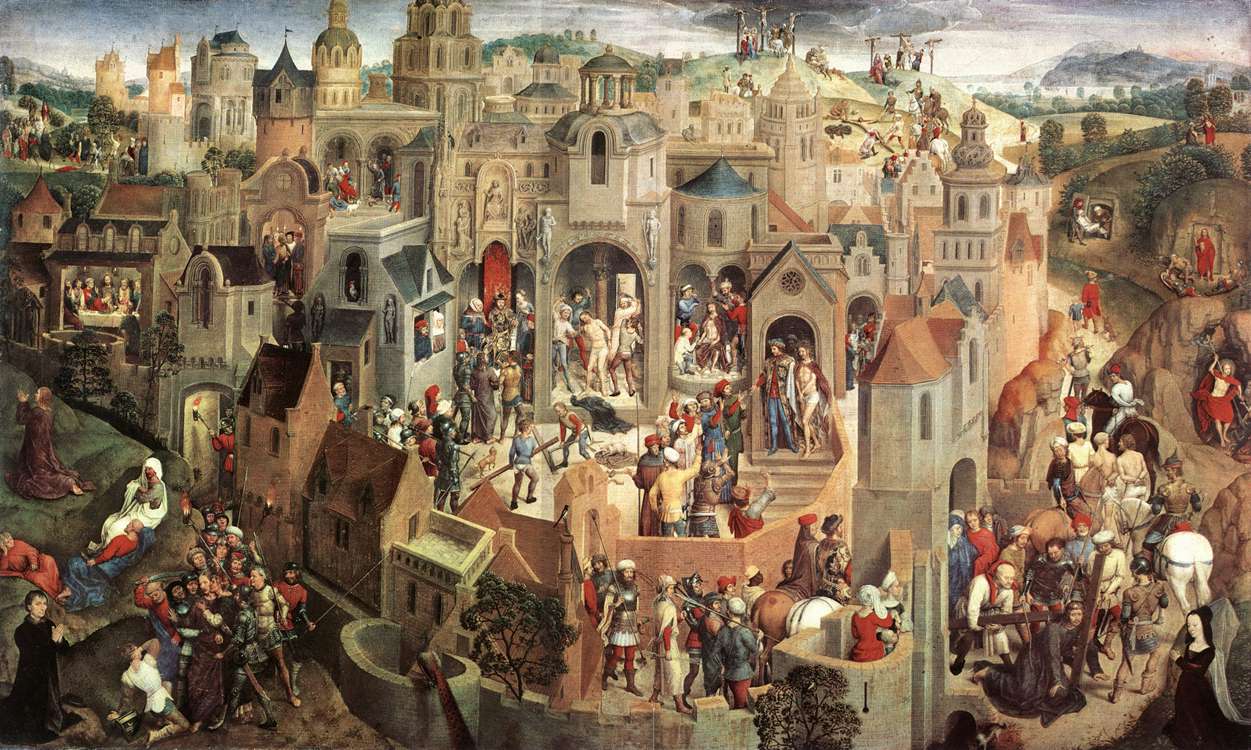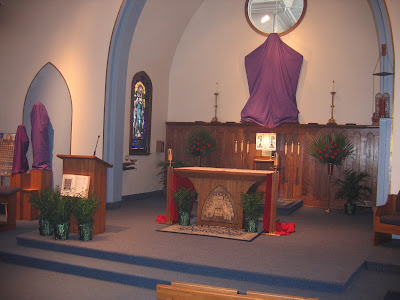So they took branches of palm trees and went out to meet him, crying, "Hosanna! Blessed is he who comes in the name of the Lord, even the King of Israel!" And Jesus found a young ass and sat upon it; as it is written, "Fear not, daughter of Zion; behold, your king is coming, sitting on an ass's colt (Jn 12:13-15)!"
Today we commemorate Christ's entry into Jerusalem for the completion of the Paschal Mystery. In the old calendar before Vatican II, the Church celebrated Passion Sunday two Sundays before Easter, and then Palm Sunday was the beginning of Holy Week. The Church has combined the two to reinforce the solemnity of Holy Week.
The Palm Sunday procession is formed of Christians who, in the "fullness of faith," make their own the gesture of the Jews and endow it with its full significance. Following the Jews' example we proclaim Christ as a Victor... Hosanna to the Son of David! Blessed is He who comes in the Name of the Lord. But by our faith we know, as they did not, all that His triumph stands for. He is the Messiah, the Son of David and the Son of God. He is the sign of contradiction, acclaimed by some and reviled by others. Sent into this world to free us from sin and the power of Satan, He underwent His Passion, the punishment for our sins, but comes forth triumphant from the tomb, the victor over death, making our peace with God and taking us with Him into the kingdom of His Father in heaven.
Liturgy for Palm Sunday
The priest wears red vestments for Mass. There is a special entrance at the beginning of each Mass, either simple or solemn. This includes a blessing of the palms and the gospel reading of the entrance into Jerusalem (this year Luke 19:28-40). The introduction by the priest explains the solemnity of Holy Week, and invites the faithful to take full part in the celebration:
The priest wears red vestments for Mass. There is a special entrance at the beginning of each Mass, either simple or solemn. This includes a blessing of the palms and the gospel reading of the entrance into Jerusalem (this year Luke 19:28-40). The introduction by the priest explains the solemnity of Holy Week, and invites the faithful to take full part in the celebration:
Dear friends in Christ, for five weeks of Lent we have been preparing, by works of charity and self-sacrifice, for the celebration of our Lord's paschal mystery. Today we come together to begin this solemn celebration in union with the whole Church throughout the world. Christ entered in triumph into his own city, to complete his work as our Messiah: to suffer, to die, and to rise again. Let us remember with devotion this entry which began his saving work and follow him with a lively faith. United with him in his suffering on the cross, may we share his resurrection and new life.
The palms are blessed with the following prayer:
Almighty God, we pray you bless these branches and make them holy. Today we joyfully acclaim Jesus our Messiah and King. May we reach one day the happiness of the new and everlasting Jerusalem by faithfully following him who lives and reigns for ever and ever. Amen.
As the faithful, we remember and dramatize Christ's triumphal entrance into Jerusalem on a donkey. In Jesus' time, a huge crowd assembled, put their cloaks or branches on the ground, and waved palm branches, acclaiming Christ as the King of Israel, the Son of David. We now wave our palm branches and sing as the priest enters the church:
Hosanna to the Son of David,
the King of Israel.
Blessed is he who comes
in the name of the Lord.
Hosanna in the highest.
These words of praise are echoed every day at the Holy Sacrifice of the Mass at the Sanctus (Holy, Holy).
Our joy, however, is quickly subdued. We are jolted to reality and see the purpose of Christ coming to Jerusalem by the reading of the Passion at the Gospel.
When Mass is finished, we take the palms home and hang them over crucifixes or holy pictures. Another custom is to shape the palm into Crosses before hanging them. The people of Italy and Mexico shape palms into extremely elaborate and beautiful figures. Also, men in some places will wear a piece of it in their hats or pin it to their lapels.
Some of these same palm branches are saved and burned the next year to make the ashes for the next Ash Wednesday -- the palms, which symbolize triumph, and the ashes, which symbolize death and penitence, forming a great symbolic connection between suffering and victory. Next year, when we get new palms, the old palms are burned and their ashes buried.
Some of these same palm branches are saved and burned the next year to make the ashes for the next Ash Wednesday -- the palms, which symbolize triumph, and the ashes, which symbolize death and penitence, forming a great symbolic connection between suffering and victory. Next year, when we get new palms, the old palms are burned and their ashes buried.
The Monday, Tuesday, and Wednesday following Palm Sunday are another traditional time of cleaning. Just as the house is cleaned during Advent in preparation for Christmas, and just as "Mardis Gras" is spent cleaning in preparation for Lent, these days are spent in preparation of the greatest Feast of the Church year: the Feast of Easter. By Wednesday night, and the celebration of Tenebrae, the house should be spotless so that the days of the Sacred Triduum (Holy Thursday, Friday, and Saturday) can be devoted to Christ's Passion.






No comments:
Post a Comment